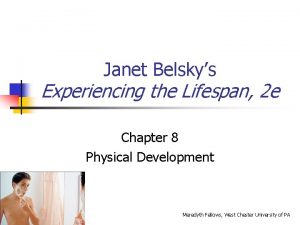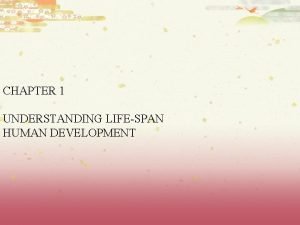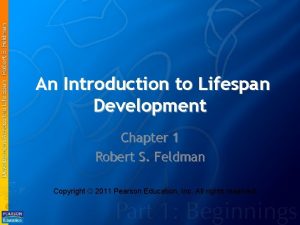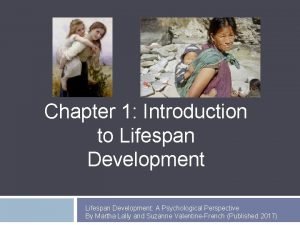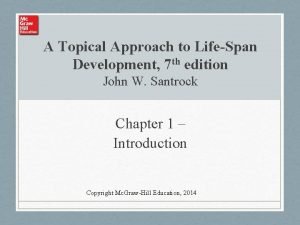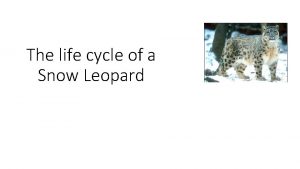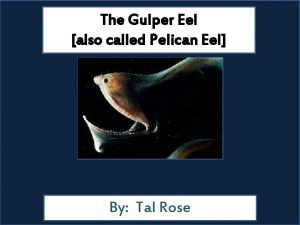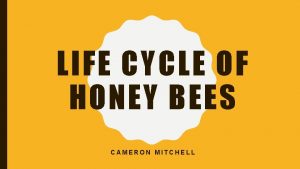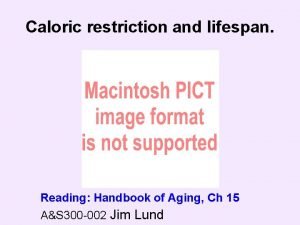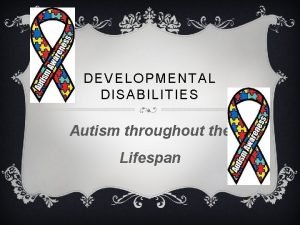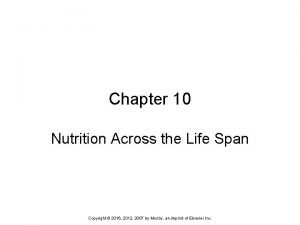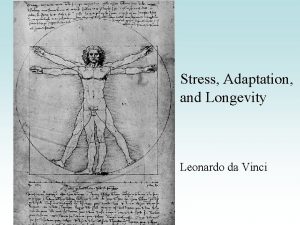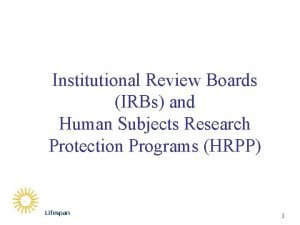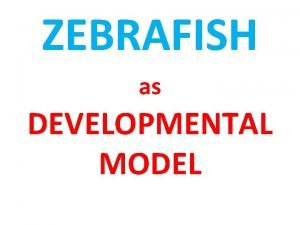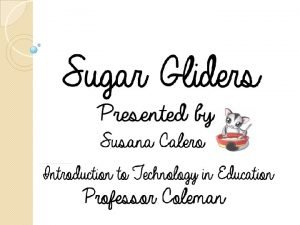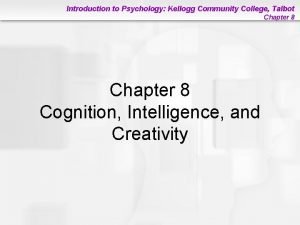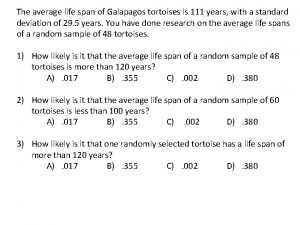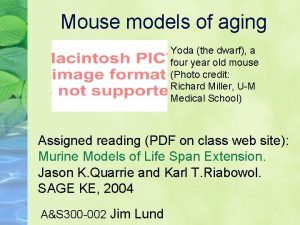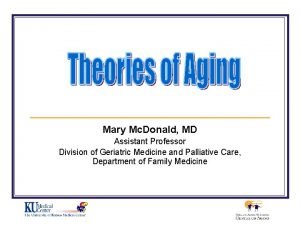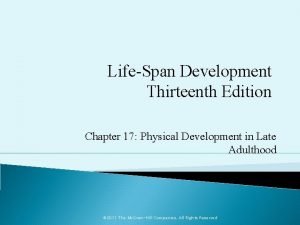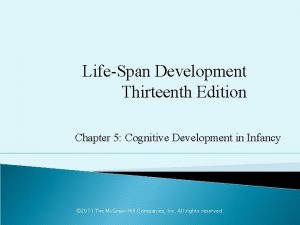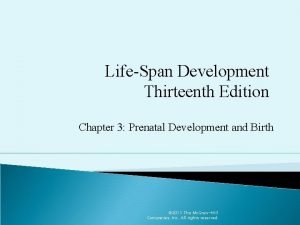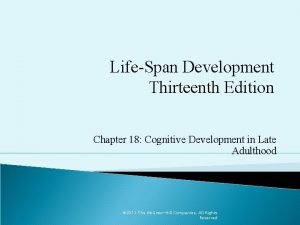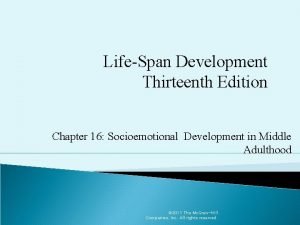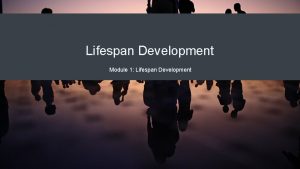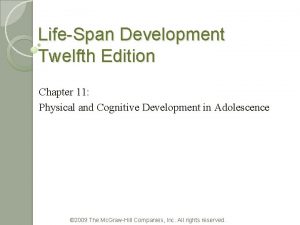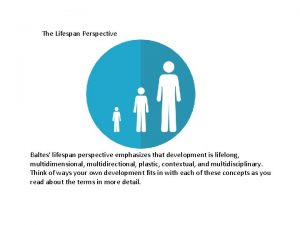LifeSpan Development Thirteenth Edition Chapter 4 Physical Development





































- Slides: 37

Life-Span Development Thirteenth Edition Chapter 4: Physical Development in Infancy © 2011 The Mc. Graw-Hill Companies, Inc. All rights reserved.

Physical Growth and Development in Infancy Patterns of Growth: Cephalocaudal Pattern: sequence in which the earliest growth always occurs from the top downward Proximodistal Pattern: sequence in which growth starts in the center of the body and moves toward the extremities © 2011 The Mc. Graw-Hill Companies, Inc. All rights reserved. 2

Physical Growth and Development in Infancy Height and Weight Average North American newborn is 20 inches long and 7 ½ pounds At 2 years of age, infants weigh 26 to 32 pounds and are half their adult height. © 2011 The Mc. Graw-Hill Companies, Inc. All rights reserved. 3

Physical Growth and Development in Infancy The Brain: Contains approximately 100 billion neurons at birth Extensive brain development continues after birth, through infancy, and later Head should be protected Shaken Baby Syndrome: brain swelling and hemorrhaging from child abuse trauma © 2011 The Mc. Graw-Hill Companies, Inc. All rights reserved. 4

Physical Growth and Development in Infancy The Brain: The Brain’s Development At birth, the brain is 25% of its adult weight; at 2 years of age, it is 75% of its adult weight Mapping the Brain Frontal, Occipital, Temporal, and Parietal Lobes Lateralization Left-brained vs. Right-brained © 2011 The Mc. Graw-Hill Companies, Inc. All rights reserved. 5

Physical Growth and Development in Infancy © 2011 The Mc. Graw-Hill Companies, Inc. All rights reserved. 6

Physical Growth and Development in Infancy The Brain: Changes in Neurons Continued myelination Greater connectivity and new neural pathways Changes in Regions of the Brain Dramatic “blooming and pruning” of synapses in the visual, auditory, and prefrontal cortex © 2011 The Mc. Graw-Hill Companies, Inc. All rights reserved. 7

Physical Growth and Development in Infancy © 2011 The Mc. Graw-Hill Companies, Inc. All rights reserved. 8

Physical Growth and Development in Infancy Changes in regions of the brain: ◦ “Blooming and pruning” of synapses varies by brain region ◦ Pace of myelination varies as well © 2011 The Mc. Graw-Hill Companies, Inc. All rights reserved. 9

Physical Growth and Development in Infancy The Brain: Early Experience and the Brain Depressed brain activity has been found in children who grow up in a deprived environment Repeated experience wires (and rewires) the brain Brain is both flexible and resilient © 2011 The Mc. Graw-Hill Companies, Inc. All rights reserved. 10

Physical Growth and Development in Infancy The Brain © 2011 The Mc. Graw-Hill Companies, Inc. All rights reserved. 11

Physical Growth and Development in Infancy Sleep Typical newborn sleeps 18 hours per day Infants vary in their preferred times for sleeping Most common infant sleep-related problem is night waking Consistently linked to excessive parental involvement in sleeprelated interactions with their infant © 2011 The Mc. Graw-Hill Companies, Inc. All rights reserved. 12

Physical Growth and Development in Infancy Sleep REM Sleep – eyes flutter beneath closed lids Sleep cycle begins with REM sleep in infants May provide infants with added self-stimulation REM sleep may also promote brain development We do not know whether infants dream or not © 2011 The Mc. Graw-Hill Companies, Inc. All rights reserved. 13

Physical Growth and Development in Infancy Sleep Shared Sleeping Varies from culture to culture American Academy of Pediatrics discourages shared sleeping Potential benefits: Promotes breast feeding and a quicker response to crying Allows mother to detect potentially dangerous breathing pauses in baby © 2011 The Mc. Graw-Hill Companies, Inc. All rights reserved. 14

Physical Growth and Development in Infancy Sleep SIDS (Sudden Infant Death Syndrome): infants stop breathing and die without apparent cause Highest cause of infant death in U. S. annually Highest risk is 2 -4 months of age Many other risk factors associated with SIDS © 2011 The Mc. Graw-Hill Companies, Inc. All rights reserved. 15

Physical Growth and Development in Infancy Nutritional Needs and Eating Behavior 50 calories per day for each pound they weigh Fruits and vegetables by end of 1 st year Poor dietary patterns lead to increasing rates of overweight and obese infants Breast feeding reduces risk of obesity © 2011 The Mc. Graw-Hill Companies, Inc. All rights reserved. 16

Physical Growth and Development in Infancy Nutrition © 2011 The Mc. Graw-Hill Companies, Inc. All rights reserved. 17

Physical Growth and Development in Infancy Nutrition Breast Versus Bottle Feeding Consensus: Breast feeding is better American Academy of Pediatrics strongly endorses breast feeding throughout the first year Numerous outcomes for child and mother © 2011 The Mc. Graw-Hill Companies, Inc. All rights reserved. 18

Physical Growth and Development in Infancy Nutrition Malnutrition in Infancy Early weaning can cause malnutrition Two life-threatening conditions resulting from malnutrition Marasmus: a severe protein-calorie deficiency resulting in a wasting away of body tissues Kwashiorkor: a severe protein deficiency that causes the abdomen and feet to swell with water Severe and lengthy malnutrition is detrimental to physical, cognitive, and social development © 2011 The Mc. Graw-Hill Companies, Inc. All rights reserved. 19

Motor Development The Dynamic Systems View: Infants assemble motor skills for perceiving and acting Motor skills represent solutions to goals Development is an active process in which nature and nurture work together as part of an ever-changing system © 2011 The Mc. Graw-Hill Companies, Inc. All rights reserved. 20

Motor Development Reflexes: built-in reactions to stimuli; automatic and inborn Rooting Reflex Sucking Reflex Moro Reflex Grasping Reflex Some reflexes continue throughout life; others disappear several months after birth © 2011 The Mc. Graw-Hill Companies, Inc. All rights reserved. 21

Motor Development Gross Motor Skills: large-muscle activities The Development of Posture – a dynamic process linked with sensory information in the skin, joints, and muscles, which tell us where we are in space Learning to Walk Occurs about the time of their first birthday Infants learn what kinds of places and surfaces are safe for locomotion © 2011 The Mc. Graw-Hill Companies, Inc. All rights reserved. 22

Motor Development Gross Motor Skills: large-muscle activities The First Year: Motor Development Milestones and Variations Some milestones vary by as much as two to four months Experience can modify the onset of motor accomplishments Some infants do not follow the standard sequence of motor development © 2011 The Mc. Graw-Hill Companies, Inc. All rights reserved. 23

Motor Development © 2011 The Mc. Graw-Hill Companies, Inc. All rights reserved. 24

Motor Development Gross Motor Skills Development in the Second Year Toddlers become more skilled and mobile By 13 -18 months, toddlers can pull a toy or climb stairs; by 18 -24 months, toddlers can walk quickly, balance on their feet, walk backward and stand kick a ball Even when motor activity is restricted, many infants reach motor milestones at a normal age © 2011 The Mc. Graw-Hill Companies, Inc. All rights reserved. 25

Motor Development Fine Motor Skills: finely tuned movements Using a spoon, buttoning a shirt, reaching and grasping Palmer grasp: grasping with the whole hand Pincer grip: grasping with the thumb and forefinger Perceptual-motor coupling is necessary for infants to coordinate grasping © 2011 The Mc. Graw-Hill Companies, Inc. All rights reserved. 26

Sensory and Perceptual Development What are Sensation and Perception? Sensation: occurs when information interacts with sensory receptors (eyes, ears, tongue, nostrils, and skin) Perception: the interpretation of what is sensed © 2011 The Mc. Graw-Hill Companies, Inc. All rights reserved. 27

Sensory and Perceptual Development What are Sensation and Perception? Ecological View: we directly perceive information that exists in the world around us Affordances: opportunities for interaction offered by objects that fit within our capabilities to perform activities © 2011 The Mc. Graw-Hill Companies, Inc. All rights reserved. 28

Sensory and Perceptual Development Visual Perception Visual Acuity and Human Faces Newborn’s vision is about 20/240 but 20/40 by 6 months of age Infants show an interest in human faces soon after birth Spend more time looking at their mother’s face than a stranger’s face as early as 12 hours after being born A 2 -month-old scans much more of the face than the 1 -month-old Color Vision © 2011 The Mc. Graw-Hill Companies, Inc. All rights reserved. 29

Sensory and Perceptual Development Visual Perception 1 month 2 months 3 months © 2011 The Mc. Graw-Hill Companies, Inc. All rights reserved. 1 year 30

Sensory and Perceptual Development Visual Perception © 2011 The Mc. Graw-Hill Companies, Inc. All rights reserved. 31

Sensory and Perceptual Development Visual Perception Perceptual Constancy: sensory stimulation is changing but perception of the physical world remains constant Size Constancy: recognition that an object remains the same even though the retinal image of the object changes Babies as young as 3 months show size constancy Shape Constancy: recognition that an object remains the same shape even though its orientation to us changes © 2011 The Mc. Graw-Hill Companies, Inc. All rights reserved. 32

Sensory and Perceptual Development Visual Perception Depth Perception Eleanor Gibson and Richard Walk studied development of depth perception using a “visual cliff” Infants 6 -12 months old can distinguish depth Nature, Nurture, and the Development of Infants’ Visual Perception © 2011 The Mc. Graw-Hill Companies, Inc. All rights reserved. 33

Sensory and Perceptual Development Depth Perception © 2011 The Mc. Graw-Hill Companies, Inc. All rights reserved. 34

Sensory and Perceptual Development Other Senses Hearing Fetuses can hear and learn sounds during the last two months of pregnancy and can recognize their mother’s voice at birth Touch and Pain Newborns do respond to touch and can also feel pain © 2011 The Mc. Graw-Hill Companies, Inc. All rights reserved. 35

Sensory and Perceptual Development Other Senses Smell Newborns can differentiate odors Taste Sensitivity to taste may be present before birth © 2011 The Mc. Graw-Hill Companies, Inc. All rights reserved. 36

Sensory and Perceptual Development Intermodal Perception: the ability to integrate information from two or more sensory modalities Perceptual–Motor Coupling: perception and action are coupled Action educates perception © 2011 The Mc. Graw-Hill Companies, Inc. All rights reserved. 37
 Development through the lifespan 6th edition
Development through the lifespan 6th edition Lifespan development third edition
Lifespan development third edition Lifespan development third edition
Lifespan development third edition Janet belsky
Janet belsky Chapter 9 lifespan development
Chapter 9 lifespan development Introduction to lifespan development
Introduction to lifespan development Exploring lifespan development chapter 1
Exploring lifespan development chapter 1 Sociocultural graded influences
Sociocultural graded influences Lifespan development a psychological perspective
Lifespan development a psychological perspective A topical approach to lifespan development
A topical approach to lifespan development Guidance counselling and lifespan development
Guidance counselling and lifespan development Using mis (10th edition) 10th edition
Using mis (10th edition) 10th edition Zulily case study
Zulily case study Leopards life cycle
Leopards life cycle Pictures of gulper eels
Pictures of gulper eels Display petit fours
Display petit fours Splendour beetle
Splendour beetle Life cycle of a honey bee
Life cycle of a honey bee Ponce de leon nationality
Ponce de leon nationality Henry hudson lifespan
Henry hudson lifespan Lifespan of every animal
Lifespan of every animal The developing person through the life span 9th edition
The developing person through the life span 9th edition Prairie dogs fun facts
Prairie dogs fun facts Autism lifespan
Autism lifespan Chapter 10 nutrition
Chapter 10 nutrition Eagle plucks out beak and talons
Eagle plucks out beak and talons Da vinci lifespan
Da vinci lifespan Lifespan irb
Lifespan irb Henry hudson katherine hudson
Henry hudson katherine hudson Portuguese man of war habitat
Portuguese man of war habitat Lifespan of platelets
Lifespan of platelets Nudibranch scientific name
Nudibranch scientific name Zebrafish lifespan
Zebrafish lifespan How long are sugar gliders pregnant
How long are sugar gliders pregnant Concept formation in lifespan psychology
Concept formation in lifespan psychology Galapagos turtle lifespan
Galapagos turtle lifespan Yoda lifespan
Yoda lifespan Mary wollstonecraft lifespan
Mary wollstonecraft lifespan



